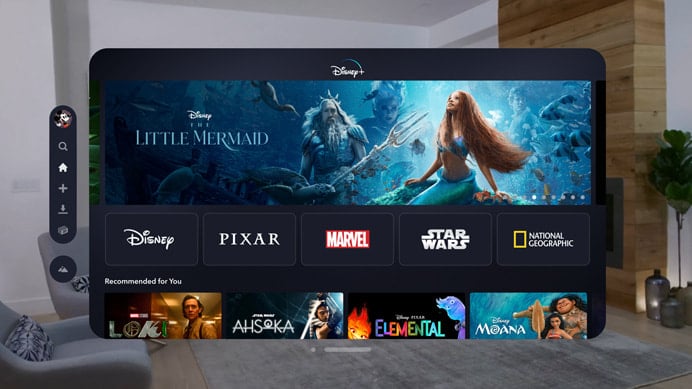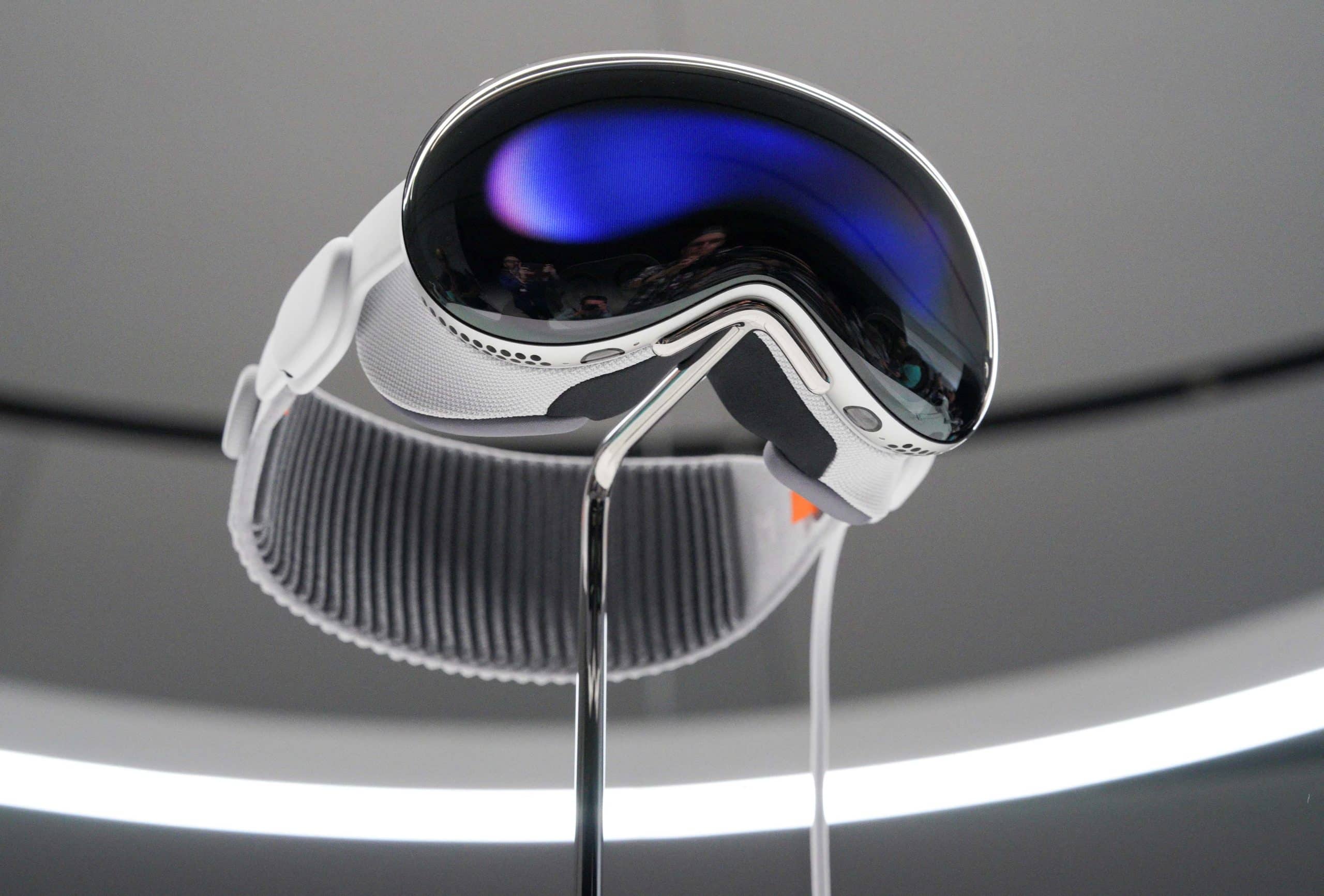Ever since Apple announced its Vision Pro AR/VR headset it has claimed that it will singlehandedly revolutionize media consumption as an ultimate entertainment device with immersive screening capabilities rivaling an IMAX theater. Netflix apparently doesn’t agree as it refused to build a native app for the headset unlike most of its competitors.
Instead, Netflix subscribers will have to access the service through a web browser within the Vision Pro’s visionOS operating system. This means that they won’t be able to enjoy special immersive environments and offline viewing offered by other streaming apps announced for the $3,499 headset.
Netflix (NFLX) provided a statement that “members will be able to enjoy Netflix on the web browser on the Vision Pro, similar to how our members can enjoy Netflix on Macs.” They appear to have opted out of developing a native visionOS app and are allowing their iPad app to run on the headset.
Competitor Streaming Apps Fully Embrace Vision Pro Capabilities

Netflix’s decision contrasts those of major Vision Pro streaming partners like Disney+, which introduced themed 3D environments based on Star Wars, Marvel, and other franchises. The Disney+ Theater environment even lets users customize seats and transport themselves into the El Capitan Theater in Hollywood.
Discovery+, Paramount+, Amazon Prime Video, and other streaming services are also launching apps that tap into the headset’s twin 4K displays with embedded spatial audio. Apple’s own TV and Music apps will showcase new immersive content shot for the Vision Pro using a multi-camera VR capture rig.
Netflix’s absence may be partially attributed to its rivalry with Apple TV+, the tech giant’s own streaming platform stocked with exclusive original content. However, with the Vision Pro being promoted as a revolutionary entertainment portal, having limited Netflix access could dampen enthusiasm amongst prospective early adopters.
Will Netflix’s Absence Undermine the Vision Pro’s Entertainment Appeal?
When previewing the Vision Pro’s entertainment features, Apple SVP of Worldwide Marketing Greg Joswiak proclaimed that it is the “ultimate entertainment device” that “will bring fans closer to the characters and stories they love”.
However, without one of people’s go-to streaming apps, the Vision Pro loses some sheen as the one-stop theater replacement Joswiak described. The device already faces headwinds as it needs to gain traction amid its lofty $3,499 starting price. Underwhelming content relative to expectations could further curb mainstream appeal if its massive price tag isn’t enough.
Analysts partly attribute Meta Platform’s struggles selling its own Quest VR headsets to uninspiring media experiences beyond gaming. Apple (AAPL) likely wants to avoid similar entertainment ecosystem issues with its AR debut.
Buyers will still have access to thousands of movies, shows, music, games, and immersive videos via the Vision Pro’s robust streaming app portfolio, though most will not be purpose-built for a VR experience. In addition, Netflix could eventually release an app if the Vision Pro establishes a large audience of engaged users.
For now, web access limits the platform’s full integration with the Vision Pro’s capabilities but the service’s content remains watchable for interested early adopters.
It is worth noting that developing an app for such a different type of device like the Vision Pro may demand a huge investment on the part of Netflix, whose library of content and interface may need to be redesigned and tailored to the needs and technical specifications required by an AR/VR gadget.
Does Apple Really Think the Vision Pro Will Replace Cinemas?
At its launch event, Apple pulled out all the stops, framing the Vision Pro as a device capable of replacing IMAX-quality screening experiences thanks to its high-resolution displays and spatial audio. Onlookers were a bit hesitant to agree as VR has been touted as the next generation of media for years and years and it simply hasn’t caught on yet.
The Vision Pro isn’t just any VR headset, however. It can replicate a 100-foot movie screen with perfect image geometry and make any content more immersive via environments like the Apple TV app’s virtual cinema.
This could be comparable to watching a Formula 1 race on a colossal floating screen overlooking a detailed 3D Monaco race course thanks to the Vision Pro’s ability to map and integrate physical rooms.
Also read: Apple’s Vision Pro Headset is Too High Quality
This sets the stage for the Vision Pro serving as an unlimited personal theater where the headset maps room layouts and dynamically adjusts audio based on a user’s position.
Early Vision Pro reviews praise the visual fidelity as superior to existing VR devices. So, while missing Netflix support slightly dampens its versatility, Apple still managed to attract a myriad of entertainment options.
In tandem with the hardware reveal, Apple announced a lineup of entertainment partners supporting Vision Pro with dedicated apps or content at launch.
Streaming services offering native visionOS apps include Disney+, Discovery+, Amazon Prime Video, Paramount+, Peacock, Pluto TV, and Tubi. Others, like Netflix, will be accessible through web browsers.
Both Disney+ and Apple TV+ plan to debut special 3D environments based on popular franchises only accessible on Vision Pro. Over 150 3D movies will also be accessible to be purchased from the Apple TV app.
For gaming, 250 Apple Arcade titles will be playable on the headset alongside new VR games on the wider App Store. Apple is also launching an original prehistoric encounter simulation called “Encounter Dinosaurs” using the Vision Pro’s capabilities.
Vision Pro Features Are Tailor-Made for Cinematic Entertainment
Drance and other Apple presenters highlighted the Vision Pro’s specialized display, audio, and input technologies allowing entertainment consumption that pushes boundaries.
Specifically, they focused on the twin ultra-high resolution micro-OLED displays with HDR and Dolby Vision output of 23 million pixels directed to each eye that engulf a user’s field of view.
Moreover, spatial audio via specially designed buds or AirPods Pro pipes will be in perfect sync with display positioning.
Hand-and-eye tracking capabilities enable controlling Vision Pro through simple gestures for completely controller-free operation. Meanwhile, AI-powered software is used to automatically adapt lighting and screen positioning to optimize viewing experiences.
This all sounds great but the massive price tag and the many problems that plague the medium like motion sickness will likely make this device a rare enthusiast gadget and not a media revolution.
